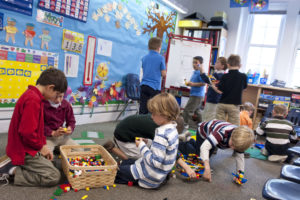
You spend eight hours or more every day perfecting your profession, working your way up, and supporting your family. What does your 4-year-old do all day?
He plays.
As the teachers at The Fessenden School say, “Play is the work of childhood.” And the experts agree: Play is just as important to growing young minds as your career is to your personal growth.
Here are three expert takes on the importance of play in the pre-K classroom:
Play in pre-K is learning.
Commenting on the advent of universal pre-K in New York City, Shael Polakow-Suransky, former senior deputy chancellor of the NYC Department of Education, and Nancy Nager, a professor of education and child development, observe that play is sometimes pushed out of the classroom in favor of formal academic work.
The two aren’t mutually exclusive, the pair contends. Children are wired to learn important lessons through play.
“As they play, children develop vital cognitive, linguistic, social and emotional skills. They make discoveries, build knowledge, experiment with literacy and math and learn to self-regulate and interact with others in socially appropriate ways.”
In the opinion of these two experts, “purposeful play” should be a central part of the pre-K curriculum.
Students learn to love learning through play in pre-K.
The National Association for the Education of Young Children believes so strongly in the importance of play that the organization included it in its accreditation criteria for early childhood programs: “Teaching staff are expected to encourage and facilitate active play involving physical movement as well as pretend or dramatic play. Children are expected to have opportunities to play individually and with peers.”
Peter Pizzolongo, an NAEYC official, told GreatSchools.org that when children are “learning and playing with joy…they develop a positive approach to learning.”
Fessenden’s pre-K teachers have found the same thing. Teaching boys to love learning is one of their primary objectives and play is their most powerful tool.
Here’s one example:
A pre-K teacher fills a sensory table with sand and animals of different types. She encourages her students to explore the sand, find the animals, and play with them. After a while, she replaces the animals with different shapes and again encourages her students to find them, this time, sorting them into different bins based on physical attributes.
The students are learning about the different types of shapes, but to them, the teacher explains, “It still feels very much like play and they’re enjoying it. But their academic foundation is also being built.”
(Here are a few more examples of how play in pre-K teaches students to love learning.)
Play promotes creativity and problem solving.
A few years ago, two researchers at MIT handed two groups of children a toy and asked them if they could discover its various (almost literal) bells and whistles. The researchers got one group started by directly showing them one feature. The other group was allowed to explore the toy on their own.
The researchers found that the undirected group played with the toy longer and discovered more features. Another study at Berkeley had similar results. The researchers concluded that, by being allowed to play without direction, the children demonstrated more curiosity and creativity. (These two studies are summarized here.)
This is one of the main principles behind the new playground at The Fessenden School. Instead of fixed swings and slides, the Fessenden playground comprises an intriguing collection of loose parts scattered across a landscape that includes a small stream and a large sand pit. Boys at play there naturally find challenges to accomplish, like spanning the stream with wooden pieces or digging a cavern deep enough to hide in.
As one teacher explains: “The playground creates situations where the boys have to adapt and communicate with their peers to solve real-world problems.”
Not bad for a day’s work.
What else should you look for in a high-quality pre-K program? To learn more, get your free copy of the Pre-K & Kindergarten Private School Visit Checklist.
And feel free to share your expert opinion on the importance of play in pre-K in the comments section below.






Really enjoyed reading this. As long as the children are having fun, they’re more open to learning. Interesting article! The Fessenden playground sounds like a lot of fun! And the teachers seem to have the learning objectives in mind when guiding the interaction between children. Kudos!
Thank you for pointing out that pre-K schools can help children love learning. My daughter is getting to the age where I think she could benefit from a pre k school. I’ll have to look into finding the best one for her in our area.
I visit your blog. It is really useful and easy to understand. Hope everyone get benefit. Thanks for sharing your Knowledge and experience with us.